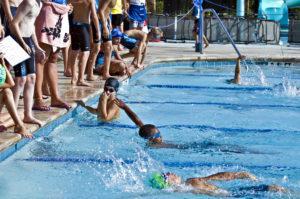The complete coaches guide for teaching swimmers a relay
Relays can be complicated for young swimmers to grasp. In this article, we’ll dive into the steps you can take as a coach to teach your swimmers a relay and its components.
Dryland relays: start out of the water
Children are in a stage in their lives where they are developing the ability to mentally manipulate objects and events in their heads, the concrete operational stage of cognitive development. Standing above them while they are in the pool and explaining the concept will never work for this young age group. Instead, there are two activities you can have your swimmers complete to teach them the concept of a relay.
Fill the bucket relay game
The best way to really engage swimmers is by teaching them through a game. This game builds the foundation of the relay idea in your swimmers minds so they can translate it to the next steps.
First find a safe area and place two buckets a good bit away from where you plan to start the relay. Place two more buckets where you plan to start and fill those with water. Divide your group into two teams. The objective is to fill the cup of water at the starting end, run to the other end, dump it into the bucket, then pass the cup to the next child. First team to fill the bucket wins.
Before you start, it’s important swimmers understand only one person can go at a time! Stress that they can’t leave before they are in possession of the cup and fill it with water. If they did, how would they fill the bucket? The core objective of this game is to teach swimmers only one person can go at a time!
It may be beneficial to split your group up into more than two teams to cycle through the swimmers faster. Feel free to use any size bucket you want to make the game last shorter or longer.
The swimmer’s baton relay
After playing the bucket relay game, the next step to teach swimmers a relay is the baton relay. We want to slowly progress swimmers to learn when they should leave in the relay. We will remove the objective of filling the bucket. This technique brings them just a little bit closer to completely understanding a proper relay.
For this activity, divide your team into as many even groups as you can make. Just like the bucket relay, find a safe location and make sure that all your participants have proper footwear on. Mark an objective that the swimmers must touch (remember, we want to give our swimmers something to physically picture and reach) and then return.
For this activity, we’re removing the cup and replacing it with a baton. But, we’re not runners…we’re swimmers. So we’re going to use a water-inspired baton…a diving stick.
Just like the bucket relay, swimmers can’t exchange before they are passed the diving stick. Continue to stress the importance that only the swimmer with the diving stick can be running. It may be harder to grasp here because there is no final, visible objective, like the bucket.
After your athletes understand this, move to relays that don’t use the diving sticks. This will be the final step in our relay progression out of the water.
Swimming relay: migrate to the pool
Now that your swimmers understand the concept of a relay, time to put it to the test in the pool.
Swimmer’s baton relay…part two
We’re going to do the exact same thing that we did with the first baton relay here, except it will just be in the water. Because this is a progression, we don’t want to remove the stick entirely…we want to slowly remove it.
For this relay, swimmers should swim freestyle with the diving stick, utilizing catchup drill. See my article detailing this catchup drill with the diving stick for more information. The next swimmer can’t leave until they have possession of the diving stick.
Racing with the diving stick will teach swimmers a relay because it gives them something specific to think about to let them know when it is ok to leave the wall and begin swimming. If you stressed the importance of not leaving until they have the object, this will be a breeze for them!
Full steam ahead!
At this point, your swimmers should be ready to progress to a full relay with no objects to assist them. Just have each swimmer leave when the swimmer in front of them finishes to the wall.
If you properly stressed the proper time to leave, your swimmers will understand exactly when to leave.


[…] Some aspects of swimming can be confusing for swimmers to grasp, like relays. Trying to explain relays to new swimmers is like trying to explain the internet to a farmer from the 1800s. But, progressing swimmers through dryland activities to teach relays makes it so much easier. Letting them explore, watching the coaches, and having fun themselves makes your objective stick in their minds much easier. As an example, check out my progression to teaching new swimmers relays. […]